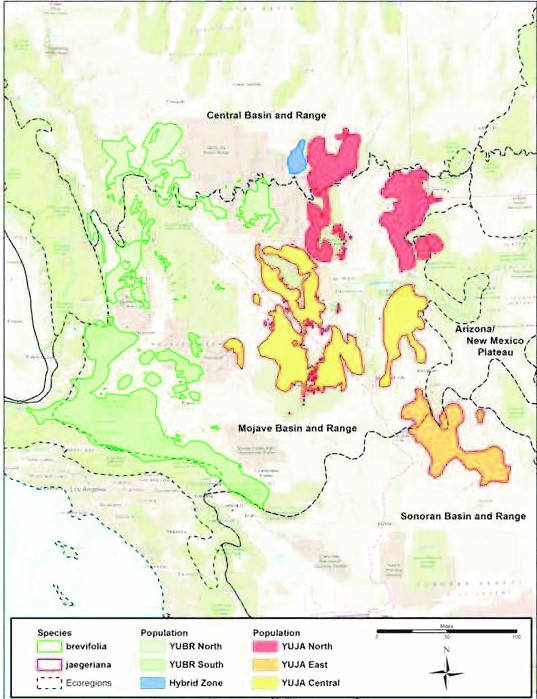Western Joshua Tree’s CESA Review Period Is Near Its End: What Have We Learned And What Should We Expect?
On September 22, 2020 the California Fish and Game Commission voted to consider the petition to list western Joshua tree (Yucca brevifolia) as threatened or endangered under the California Endangered Species Act (CESA), and subsequently listed it as a candidate species the following October. The California Department of Fish and Wildlife’s (CDFW’s) report to the Commission on the status of the species and recommendation for listing is due this April; however, pending litigation has already delayed the receipt of this consequential report several times. In spite of the multiple lawsuits underway, as a candidate species, the western Joshua tree is still afforded full protection under CESA during its review period, and take of candidate species requires an Incidental Take Permit (ITP) with protections under CESA extending to its seeds and seed bank.
Determining whether or not a project will take an individual or group of western Joshua tree and require an ITP is straight forward; however, estimating a project’s take of something as inconspicuous as a seed bank is much less so. Western Joshua tree fruits do not open on their own, and the trees are reliant on rodents, which open their fruits, collect their seeds, and store them in underground burrows . These seed caches constitute the majority of the western Joshua tree’s seed bank1. Explicitly determining whether or not a potential project would take these seed caches is effectively impossible. In order to avoid the seed banks and not take western Joshua tree, and avert the need for an ITP, it is assumed that these caches exist in close proximity to any individual western Joshua tree, but where do we draw the line? In one study conducted by Vander Wall et al.1 western Joshua tree seeds were found to be dispersed by rodents up to a mean maximum distance of 98 feet (30 meters). The largest known dispersal distance for western Joshua tree was documented by Lenz in Antelope Valley at 495 feet (151 meters) . In CDFW’s most recent ITP authorizing take of western Joshua tree, the CDFW issued an ITP in which any disturbance within 186-feet of any western Joshua tree was considered take (ITP No. 2081-2021-012-05). In addition, the CDFW has provided comment that a 290-foot no-disturbance buffer for each western Joshua tree would be required for a project to proceed without needing an ITP (SCH No.: 2019090215). As indicated by these recent ITPs and comments from CDFW, the area of land required to conserve the seed bank of each western Joshua tree will preclude many projects from seeking total avoidance, and these projects will need to obtain ITPs and provide mitigation.

If a project requires an ITP for western Joshua tree it will require mitigation, and determining the amount and quality of mitigation required can be just as nuanced as determining a project’s potential to take. It can be inferred from CDFW’s most recent ITP authorization that, depending on the habitat quality of the impact areas and the proposed mitigation lands, take of western Joshua tree and its seed bank will need to be mitigated at a ratio somewhere between 1.5:1 and 7:1 (ITP No. 2081-2021-012-05 and ITP No. 2081-2021-012-05-A1). According to this recent ITP, in addition to general mitigation acreage, the mitigation lands will need to conserve five western Joshua tree for each tree impacted. However, at this point, there is no official guidance established by CDFW on what would fully mitigate take of western Joshua tree.
Given the complex nature of determining the extent of take of western Joshua tree and the appropriate mitigation for any take, it may be tempting to delay permit applications until after the Commission’s review period has ended; however this could be a lengthy process while lawsuits continue and, consequently, western Joshua tree may remain a CESA candidate species for some time. In addition to State protections, the U.S. Fish and Wildlife Service (USFWS) was ordered by the U.S. District Court’s Central District of California on September 20, 2021, to review their decision that listing the western Joshua tree was not warranted (Case 2:19-cv-09473-ODW-KS). An imminent re-review by the Feds notwithstanding, the western Joshua tree will continue to receive protection under CESA. Given the current regulatory turmoil, incorporating a biologist into a project’s planning process as early as possible is critical for project success. This is especially important in the early stages of regulatory strategy. WRA’s regulatory specialists and conservation biologists work closely with clients to provide crucial guidance while they navigate the nuances and uncertainties of western Joshua tree regulations and conservation.
Feel free to contact us anytime. We are available and happy to help get your project permitted.
[1] Vander Wall, S.B., T. Esque, D. Haines, M. Garnett, and B. Waitman. 2006. Joshua tree (Yucca brevifolia) seeds are dispersed by seed-caching rodents. Ecoscience 13:539–543.
[2] Lenz, L.W. 2001. Seed dispersal in Yucca brevifolia (Agavaceae) present and past, with consideration of the future of the species. Aliso 20:61–74.



